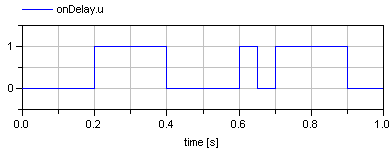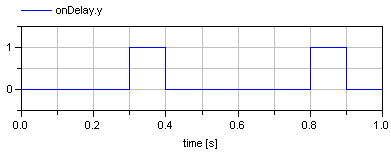Library of Boolean mathematical functions as input/output blocks
This package contains basic mathematical operations on Boolean signals.
The new features are:
Extends from Modelica.Icons.Package (Icon for standard packages).
| Name | Description |
|---|---|
| Set Boolean expression that is associated with the first active input signal | |
| Logical 'and': y = u[1] and u[2] and ... and u[nu] | |
| Logical 'or': y = u[1] or u[2] or ... or u[nu] | |
| Logical 'xor': y = oneTrue(u) (y is true, if exactly one element of u is true, otherwise it is false) | |
| Logical 'nand': y = not ( u[1] and u[2] and ... and u[nu] ) | |
| Logical 'nor': y = not ( u[1] or u[2] or ... or u[nu] ) | |
| Logical 'not': y = not u | |
| Output y is true, if the input u has a rising edge, otherwise it is false (y = edge(u)) | |
| Output y is true, if the input u has a falling edge, otherwise it is false (y = edge(not u)) | |
| Output y is true, if the input u has either a rising or a falling edge and otherwise it is false (y=change(u)) | |
| Delay a rising edge of the input, but do not delay a falling edge. |
 Modelica.Blocks.MathBoolean.MultiSwitch
Modelica.Blocks.MathBoolean.MultiSwitchSet Boolean expression that is associated with the first active input signal
The block has a vector of Boolean input signals u[nu] and a vector of (time varying) Boolean expressions expr[:]. The output signal y is set to expr[i], if i is the first element in the input vector u that is true. If all input signals are false, y is set to parameter "y_default" or the previous value of y is kept if parameter use_pre_as_default = true:
// Conceptual equation (not valid Modelica)
i = 'first element of u[:] that is true';
y = if i==0 then (if use_pre_as_default then pre(y)
else y_default)
else expr[i];
The usage is demonstrated, e.g., in example Modelica.Blocks.Examples.BooleanNetwork1.
| Name | Description |
|---|---|
| expr[nu] | Sets y = if u[i] then expr[i] else y_default (time varying) |
| use_pre_as_default | Set true to hold last value as default (y_default = pre(y)) |
| y_default | Default value of output y if all u[i] = false |
| Name | Description |
|---|---|
| u[nu] | Set y = expr[i], if u[i] = true |
| y | Output depending on expression |
 Modelica.Blocks.MathBoolean.And
Modelica.Blocks.MathBoolean.AndLogical 'and': y = u[1] and u[2] and ... and u[nu]
The output is true if all inputs are true, otherwise the output is false.
The input connector is a vector of Boolean input signals. When a connection line is drawn, the dimension of the input vector is enlarged by one and the connection is automatically connected to this new free index (thanks to the connectorSizing annotation).
The usage is demonstrated, e.g., in example Modelica.Blocks.Examples.BooleanNetwork1.
If no connection to the input connector "u" is present, the output is set to true: y=true.
Extends from Modelica.Blocks.Interfaces.PartialBooleanMISO (Partial block with a BooleanVectorInput and a BooleanOutput signal).
| Name | Description |
|---|---|
| u[nu] | Vector of Boolean input signals |
| y | Boolean output signal |
 Modelica.Blocks.MathBoolean.Or
Modelica.Blocks.MathBoolean.OrLogical 'or': y = u[1] or u[2] or ... or u[nu]
The output is true if at least one input is true, otherwise the output is false.
The input connector is a vector of Boolean input signals. When a connection line is drawn, the dimension of the input vector is enlarged by one and the connection is automatically connected to this new free index (thanks to the connectorSizing annotation).
The usage is demonstrated, e.g., in example Modelica.Blocks.Examples.BooleanNetwork1.
If no connection to the input connector "u" is present, the output is set to false: y=false.
Extends from Modelica.Blocks.Interfaces.PartialBooleanMISO (Partial block with a BooleanVectorInput and a BooleanOutput signal).
| Name | Description |
|---|---|
| u[nu] | Vector of Boolean input signals |
| y | Boolean output signal |
 Modelica.Blocks.MathBoolean.Xor
Modelica.Blocks.MathBoolean.XorLogical 'xor': y = oneTrue(u) (y is true, if exactly one element of u is true, otherwise it is false)
The output is true if exactly one input is true, otherwise the output is false.
The input connector is a vector of Boolean input signals. When a connection line is drawn, the dimension of the input vector is enlarged by one and the connection is automatically connected to this new free index (thanks to the connectorSizing annotation).
The usage is demonstrated, e.g., in example Modelica.Blocks.Examples.BooleanNetwork1.
If no connection to the input connector "u" is present, the output is set to false: y=false.
Extends from Modelica.Blocks.Interfaces.PartialBooleanMISO (Partial block with a BooleanVectorInput and a BooleanOutput signal).
| Name | Description |
|---|---|
| u[nu] | Vector of Boolean input signals |
| y | Boolean output signal |
 Modelica.Blocks.MathBoolean.Nand
Modelica.Blocks.MathBoolean.NandLogical 'nand': y = not ( u[1] and u[2] and ... and u[nu] )
The output is true if at least one input is false, otherwise the output is false.
The input connector is a vector of Boolean input signals. When a connection line is drawn, the dimension of the input vector is enlarged by one and the connection is automatically connected to this new free index (thanks to the connectorSizing annotation).
The usage is demonstrated, e.g., in example Modelica.Blocks.Examples.BooleanNetwork1.
If no connection to the input connector "u" is present, the output is set to false: y=false.
Extends from Modelica.Blocks.Interfaces.PartialBooleanMISO (Partial block with a BooleanVectorInput and a BooleanOutput signal).
| Name | Description |
|---|---|
| u[nu] | Vector of Boolean input signals |
| y | Boolean output signal |
 Modelica.Blocks.MathBoolean.Nor
Modelica.Blocks.MathBoolean.NorLogical 'nor': y = not ( u[1] or u[2] or ... or u[nu] )
The output is false if at least one input is true, otherwise the output is true.
The input connector is a vector of Boolean input signals. When a connection line is drawn, the dimension of the input vector is enlarged by one and the connection is automatically connected to this new free index (thanks to the connectorSizing annotation).
The usage is demonstrated, e.g., in example Modelica.Blocks.Examples.BooleanNetwork1.
If no connection to the input connector "u" is present, the output is set to false: y=false.
Extends from Modelica.Blocks.Interfaces.PartialBooleanMISO (Partial block with a BooleanVectorInput and a BooleanOutput signal).
| Name | Description |
|---|---|
| u[nu] | Vector of Boolean input signals |
| y | Boolean output signal |
 Modelica.Blocks.MathBoolean.Not
Modelica.Blocks.MathBoolean.NotLogical 'not': y = not u
The output is false if at least one input is true, otherwise the output is true.
The input connector is a vector of Boolean input signals. When a connection line is drawn, the dimension of the input vector is enlarged by one and the connection is automatically connected to this new free index (thanks to the connectorSizing annotation).
The usage is demonstrated, e.g., in example Modelica.Blocks.Examples.BooleanNetwork1.
Extends from Modelica.Blocks.Interfaces.PartialBooleanSISO_small (Partial block with a BooleanInput and a BooleanOutput signal and a small block icon).
| Name | Description |
|---|---|
| u | Boolean input signal |
| y | Boolean output signal |
 Modelica.Blocks.MathBoolean.RisingEdge
Modelica.Blocks.MathBoolean.RisingEdgeOutput y is true, if the input u has a rising edge, otherwise it is false (y = edge(u))
A rising edge of the Boolean input u results in y = true at this time instant. At all other time instants, y = false.
The usage is demonstrated, e.g., in example Modelica.Blocks.Examples.BooleanNetwork1.
Extends from Modelica.Blocks.Interfaces.PartialBooleanSISO_small (Partial block with a BooleanInput and a BooleanOutput signal and a small block icon).
| Name | Description |
|---|---|
| pre_u_start | Value of pre(u) at initial time |
| Name | Description |
|---|---|
| u | Boolean input signal |
| y | Boolean output signal |
 Modelica.Blocks.MathBoolean.FallingEdge
Modelica.Blocks.MathBoolean.FallingEdgeOutput y is true, if the input u has a falling edge, otherwise it is false (y = edge(not u))
A falling edge of the Boolean input u results in y = true at this time instant. At all other time instants, y = false.
The usage is demonstrated, e.g., in example Modelica.Blocks.Examples.BooleanNetwork1.
Extends from Modelica.Blocks.Interfaces.PartialBooleanSISO_small (Partial block with a BooleanInput and a BooleanOutput signal and a small block icon).
| Name | Description |
|---|---|
| pre_u_start | Value of pre(u) at initial time |
| Name | Description |
|---|---|
| u | Boolean input signal |
| y | Boolean output signal |
 Modelica.Blocks.MathBoolean.ChangingEdge
Modelica.Blocks.MathBoolean.ChangingEdgeOutput y is true, if the input u has either a rising or a falling edge and otherwise it is false (y=change(u))
A changing edge, i.e., either rising or falling, of the Boolean input u results in y = true at this time instant. At all other time instants, y = false.
The usage is demonstrated, e.g., in example Modelica.Blocks.Examples.BooleanNetwork1.
Extends from Modelica.Blocks.Interfaces.PartialBooleanSISO_small (Partial block with a BooleanInput and a BooleanOutput signal and a small block icon).
| Name | Description |
|---|---|
| pre_u_start | Value of pre(u) at initial time |
| Name | Description |
|---|---|
| u | Boolean input signal |
| y | Boolean output signal |
 Modelica.Blocks.MathBoolean.OnDelay
Modelica.Blocks.MathBoolean.OnDelayDelay a rising edge of the input, but do not delay a falling edge.
A rising edge of the Boolean input u gives a delayed output. A falling edge of the input is immediately given to the output.
Simulation results of a typical example with a delay time of 0.1 s is shown in the next figure.


The usage is demonstrated, e.g., in example Modelica.Blocks.Examples.BooleanNetwork1.
Extends from Modelica.Blocks.Interfaces.PartialBooleanSISO_small (Partial block with a BooleanInput and a BooleanOutput signal and a small block icon).
| Name | Description |
|---|---|
| delayTime | Delay time [s] |
| Name | Description |
|---|---|
| u | Boolean input signal |
| y | Boolean output signal |